3.3 Colonial Revival
The World’s Columbian Exposition: The White City and fairgrounds – Smarthistory – DR. KIMBERLY KUTZ ELLIOTT
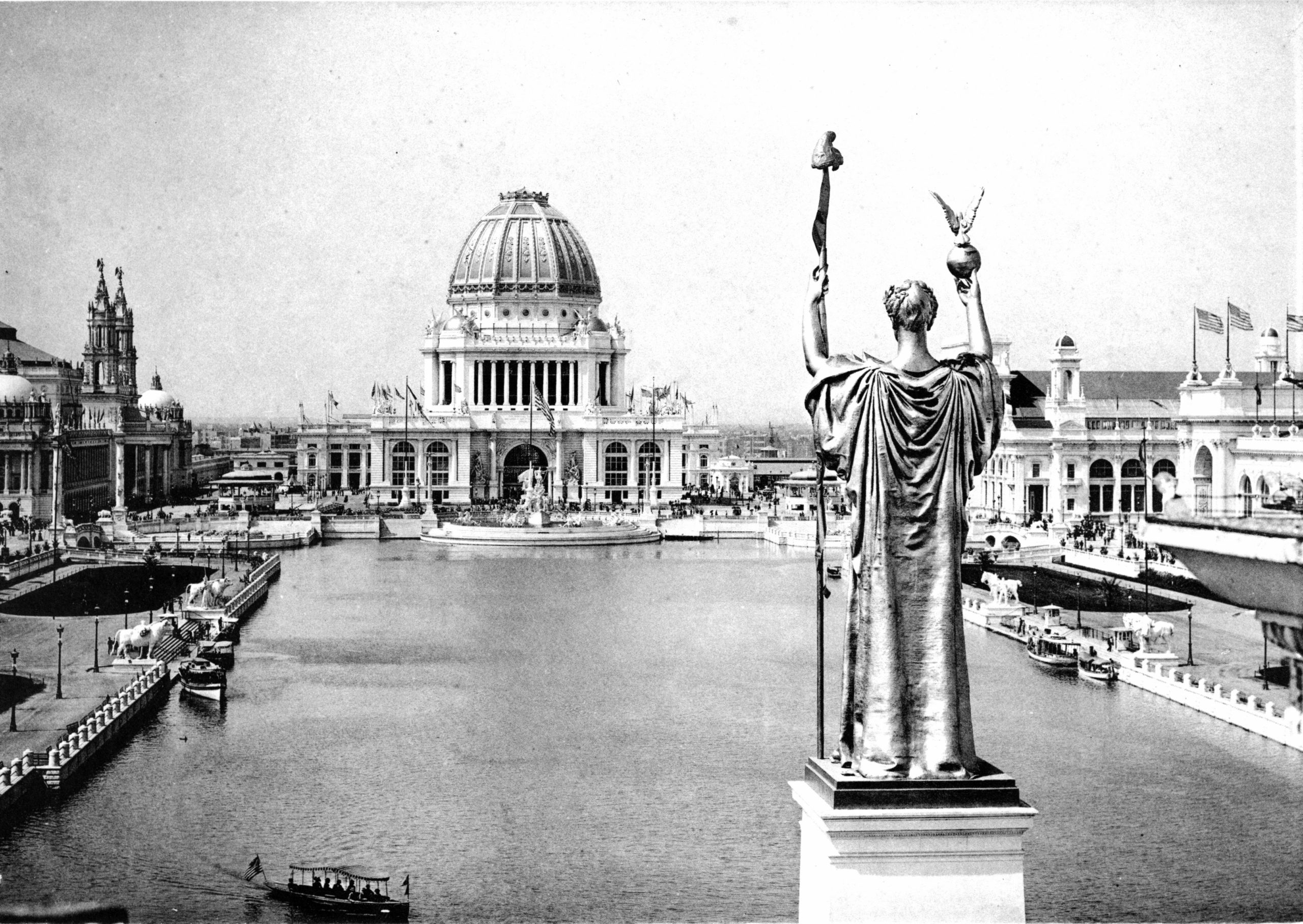
Look here, old fellow, do you realize that this is the greatest meeting of artists since the Fifteenth Century?
—AUGUSTUS SAINT-GAUDENS, ARTISTIC ADVISOR TO THE WORLD’S FAIR [1]
A visit to the World’s Fair
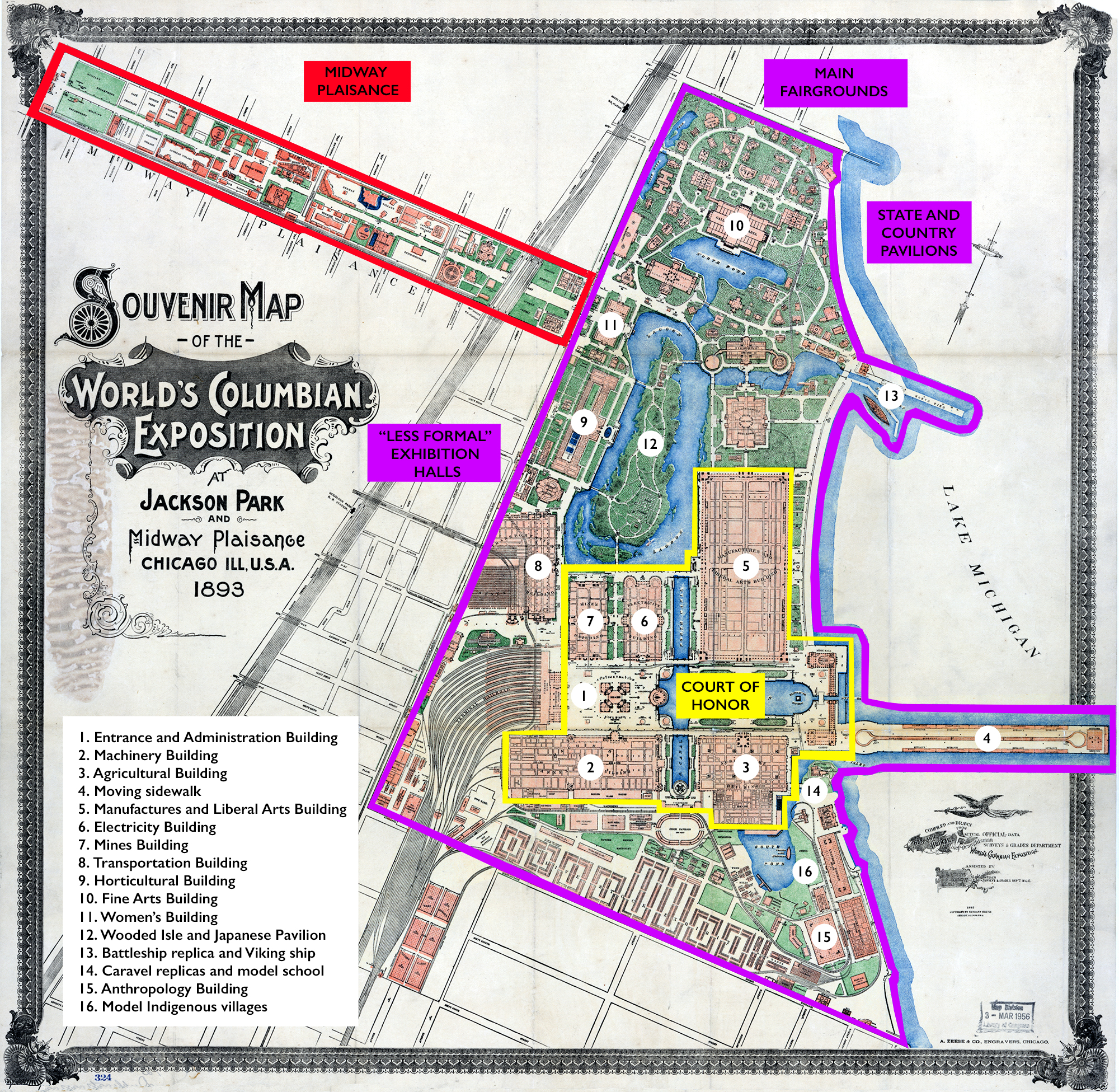
In the summer of 1893, there was no more exciting destination in the United States than the World’s Columbian Exposition. Conceived as a celebration of the anniversary of Christopher Columbus’s arrival in the Americas, the Chicago World’s Fair was a trade show, art gallery, lecture series, and museum exhibit rolled into one. (Learn more about the ideas behind and construction of the World’s Fair in this introductory essay.) Author Hamlin Garland famously wrote to his parents to “Sell the cookstove if necessary and come. You must see the fair.” [2] Everywhere the Fair was touted as a symbol of the “new era in the onward march of civilization” that heralded the ascendance of the United States in world events. Two articles of American patriotic practice emerged from the Fair: Francis J. Bellamy (cousin to Edward Bellamy, the socialist novelist quoted above who was considerably less enamored with the Fair) composed the Pledge of Allegiance to the flag of the United States for school children to recite across the country in honor of the occasion, and Katharine Lee Bates composed the song “America the Beautiful” after a western trip that included a stop at the Fair (one of its later verses includes a reference to the “alabaster” White City gleaming). [3]
The Fair consisted of two main zones: the main fairgrounds, which included the White City, and the Midway Plaisance, an adjacent carnival area. This essay will focus on the visitor experience within the main fairgrounds; you can read about the Midway Plaisance in this essay.
The White City
If a visitor arrived at the Fair by rail, she would step off the platform looking east toward Lake Michigan, with the golden-domed Administration Building immediately in front of her. To her left, the soaring archways of the Mines and Electricity Buildings welcomed her inside, while a seemingly endless row of columns decorated the front of the Machinery Building. If she walked on, she would arrive at the western end of the Grand Basin, a 1,000 foot long man-made pool that was separated from the lake by a columned peristyle. The Grand Basin and the buildings surrounding it were officially designated as the “Court of Honor,” which the Fair’s Director of Works, Daniel Burnham, cast as the “most dignified” region of the Fair, but their uniformly whitewashed façades lent them the popular name “The White City.” (Although the buildings’ exteriors were painted white to resemble marble, they were in fact made out of staff, a plaster substitute for stone that could be poured into a molded and quickly dried).
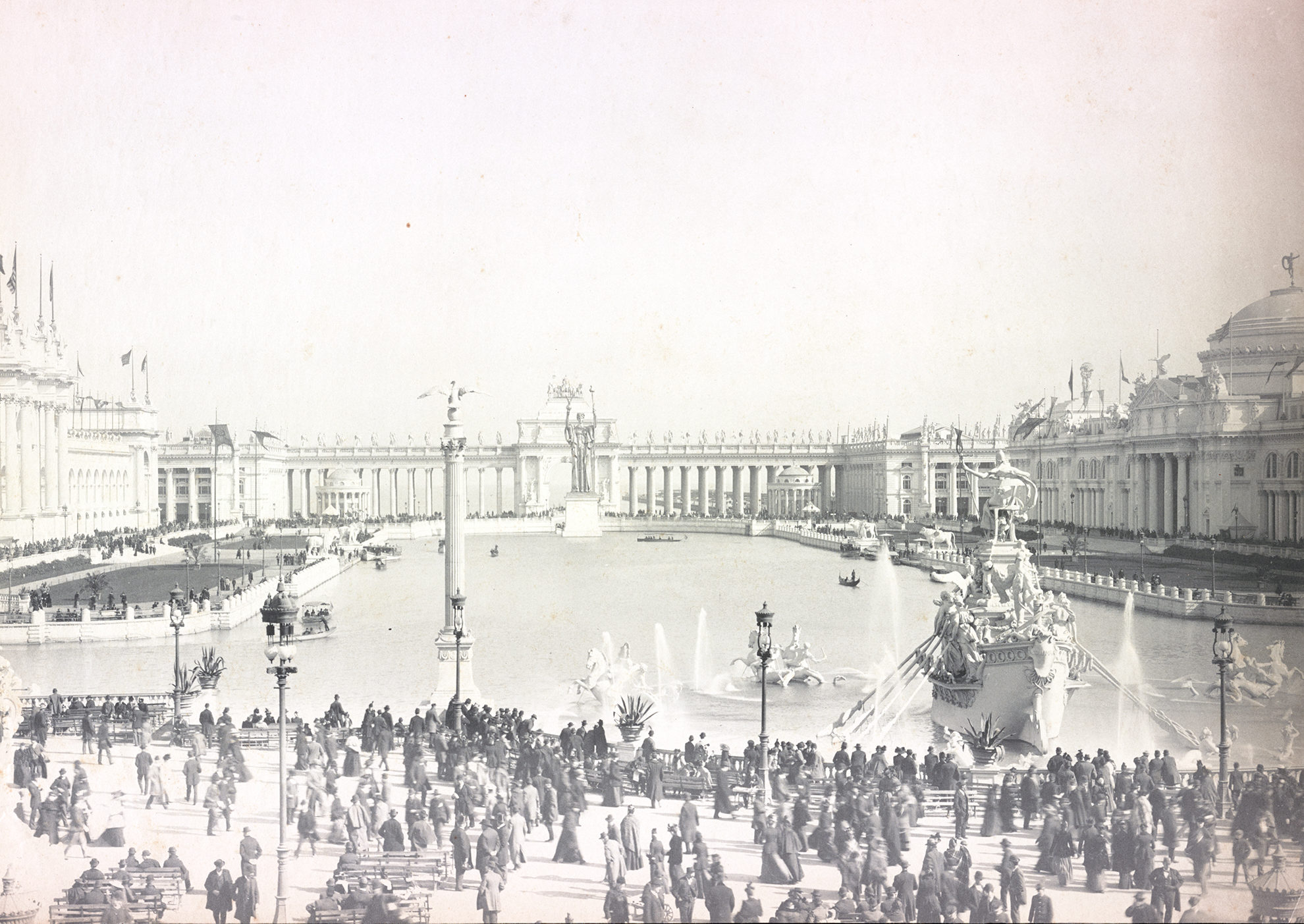
All of the buildings on the Court of Honor, as well as almost every other major exposition hall, had Beaux-Arts style façades; the leading architects of the era had trained at the École des Beaux-Arts in Paris and the style was employed for many of the public buildings commissioned during the Gilded Age. Beaux-Arts architects combined elements of Greek and Roman architecture with Italian Renaissance styles to produce buildings that were imposing, symmetrical, and ornate. The World’s Fair architects found this style particularly appropriate for their buildings because the United States was in the midst of an era of renewed nationalism after its 1876 centennial, with cultural critics declaring that the nation was the modern heir to Greek democracy, Roman law, and Renaissance humanism.
The exhibition halls of the Court of Honor were dedicated to the disciplines Burnham considered the pinnacle of human achievement (it could be argued that these are the ones most closely associated with white men: Mines, Electricity, Machinery, Agriculture, and Manufacturing). Each was an enormous steel-framed warehouse with a staff façade, designed by one of the leading architects of the era: Charles McKim, of McKim, Meade & White (of Pennsylvania Station and Columbia University fame) designed the Agricultural Building, while Richard Morris Hunt (designer of the entrance façade of the Metropolitan Museum of Art and the pedestal of the Statue of Liberty) designed the Administration Building. Taken together, the white, Beaux-Arts buildings dedicated to sciences stood as a declaration that the center of the world’s innovation and influence had moved west from Europe to the United States; and it was and ought to be under the exclusive control of white men.
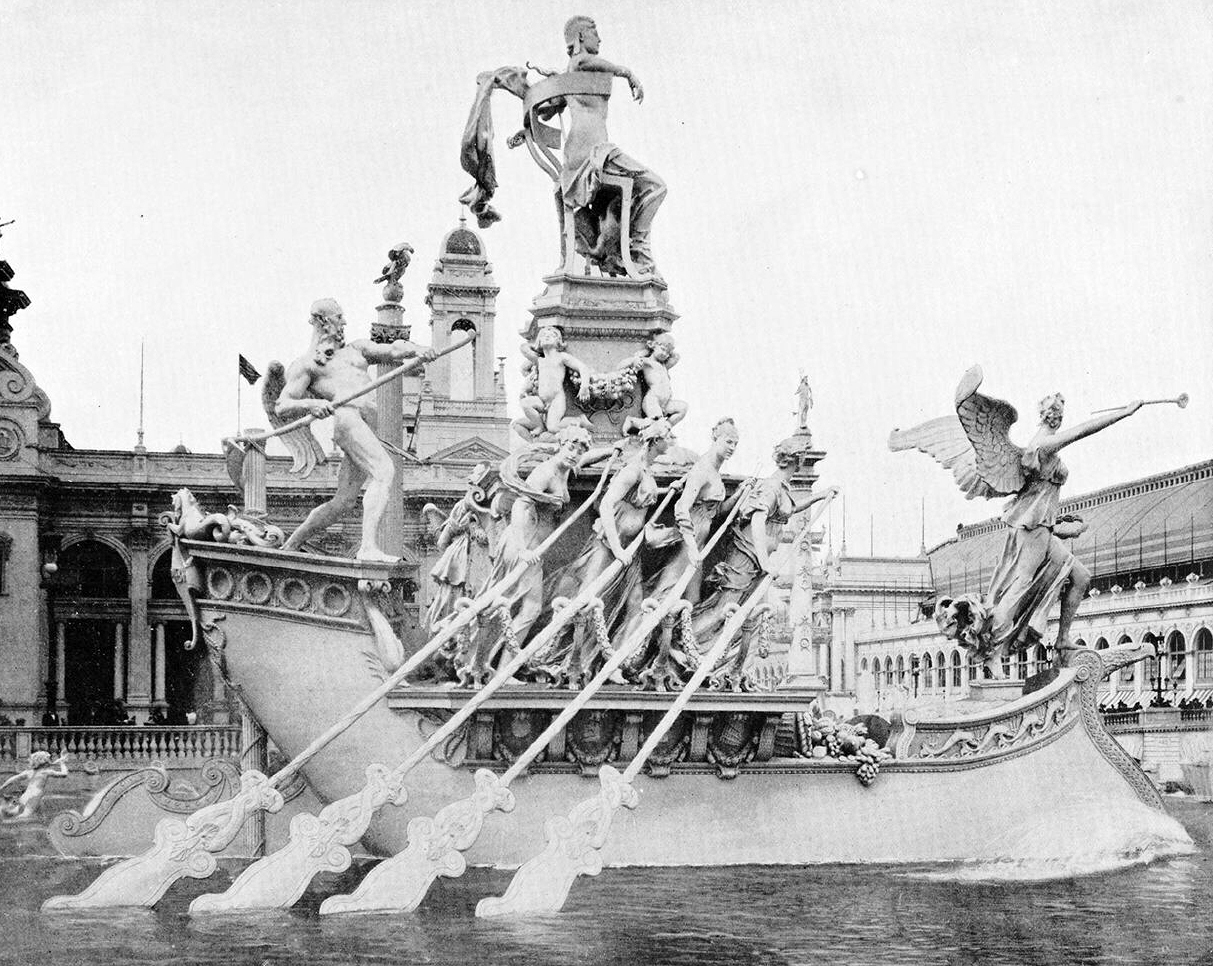
If our visitor walked on, she could gaze on the Columbian Fountain, featuring Frederick MacMonnies’s sculpture Columbia in her Grand Barge of State. Electrified and illuminated at night, the fountain’s sculpture (which does not survive) represented a number of allegorical figures, “an apotheosis of modern liberty—Columbia enthroned on a triumphal barge guided by Time, heralded by Fame, and rowed by eight standing figures, representing on one side the Arts, and on the other Science, Industry, Agriculture, and Commerce,” according to the Fair’s official guidebook. [4] A protégé of the Fair’s artistic advisor, Augustus Saint-Gaudens, MacMonnies was an emerging American sculptor who had been trained at the École des Beaux-Arts in Paris. On the far side of the Basin stood Daniel Chester French’s statue The Republic, an allegorical figure of the United States (illustrated at the top of this page), which stood more than 65 feet tall, holding an eagle perching on top of a globe in one hand, and a staff topped by a Phrygian cap in the other. Though the official guide to the Fair called these symbols an “invitation of liberty to the nations of the earth,” the eagle (the national bird of the United States) on top of the globe sent a message that all the earth was U.S. domain. [5]
Our visitor may have walked down the southern length of the Grand Basin, stopping to see the Machinery and Agricultural Buildings, the latter topped by an enormous glass dome and Augustus Saint-Gaudens’s statue of Diana, goddess of the hunt, holding a bow (it was intended for the Women’s Building but prominent women organizers objected to the statue’s nudity). If our visitor crossed through the peristyle she may have chosen to ride a moving sidewalk nearly half a mile into Lake Michigan (an innovative people-mover which helped visitors arriving by steamboat to cross the long distance to the Fair), or she may have turned back and strolled along the northern side of the Grand Basin. There, she could browse the largest building of the Fair, with more than 40 acres of floor space: the Manufactures and Liberal Arts Building, in which nations of the world displayed their finest products, and institutions trumpeted their achievements in science, medicine, education, journalism, and more.
To complete her loop of the White City, our visitor could stop by the Mines Building to see rare gems amidst the displays of coal and crude oil, and the Electricity building to see the newest inventions from Thomas Edison, Nikola Tesla, and the Bell Telephone Company. The Fair was illuminated at night thanks to the new technology of electrification, and the scientific contributions of these corporations argued for their central role in U.S. society.
The Transportation Building, Horticultural Building, and Palace of Fine Arts
The Court of Honor was perhaps the most prominent section, but there was a great deal more to see on the grounds of the World’s Fair. As Burnham described the Fair’s layout, exhibition halls “lying farther to the north—the Horticultural, Transportation, and Fisheries—being less formal, blend readily with the more or less homelike headquarters buildings of the States and foreign governments, which are grouped among the trees of the extreme northern portion of the grounds.” [6]
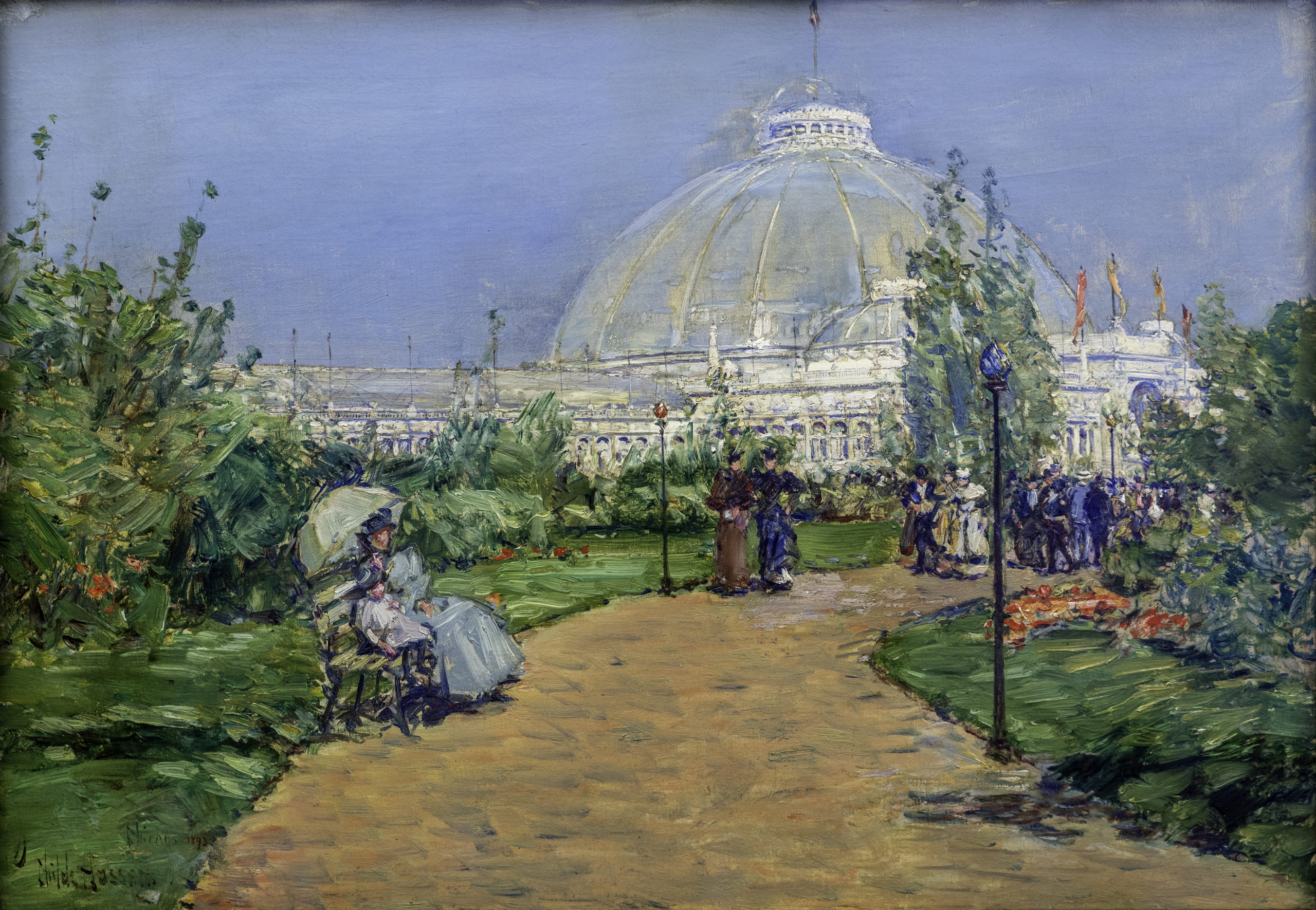
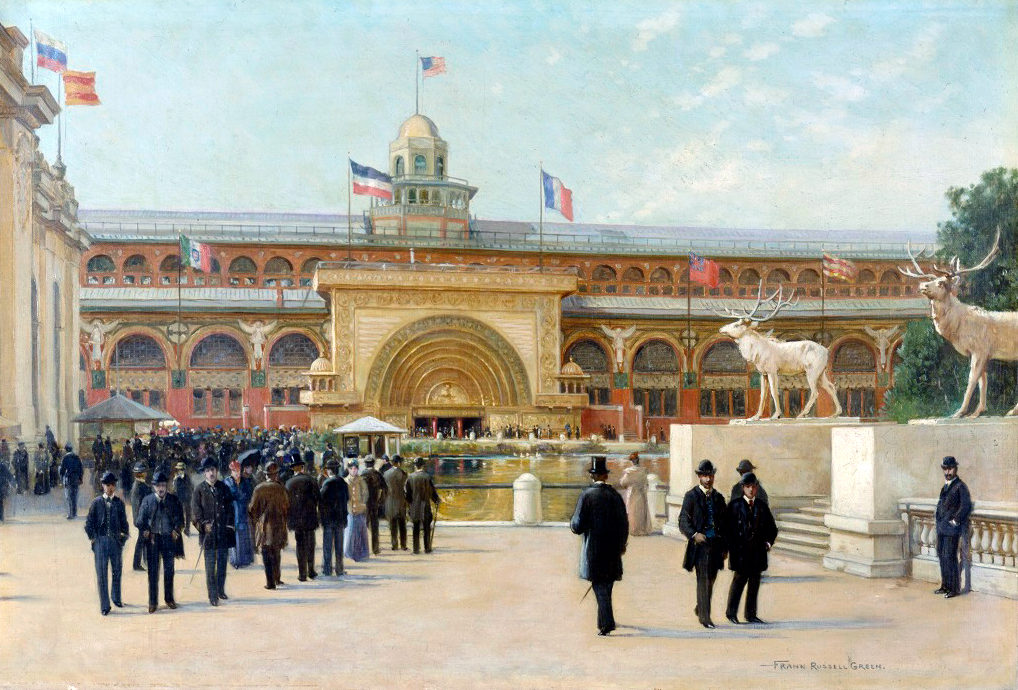
If our visitor turned north after visiting the Court of Honor, she would encounter the lagoon, which was surrounded by these “less formal” exhibition halls: the Horticultural Building, whose great glass dome allowed in sunlight in order to sustain fruits, vegetables, and flowers from all over the world, and the Transportation Building, with its celebration of railroads and steamships. Designed by Sullivan & Adler, the Transportation Building was the only exhibition hall that departed from the white, Beaux-Arts scheme: with its red walls, arched windows, and Golden Door (composed of a gold-painted quintuple arch decorated with a botanical motif) the building showcased Sullivan’s search for an new, organic American style matching form to function: an exhibition hall dedicated to transportation symbolized by a door opening to the world and arches recalling a train station.
Beyond the lagoon and north pond stood the Palace of Fine Arts (one of the only Fair buildings still extant, today it houses Chicago’s Museum of Science and Industry). Fine arts comprised painting and sculpture: works produced solely for their aesthetic value, rather than practical function. A boat dock allowed weary visitors to take advantage of the services of a gondolier to reach it, the northernmost exhibition hall. The gondolas, which cruised around the lagoon and Grand Basin, reinforced the sense that the main fairgrounds were a dream city of the Italian Renaissance, featuring not just the architectural styles but also the transportation of Venice.
Within the Palace, every available inch of wall space was crowded with pictures. Still smarting from American art’s poorly received showing at the Paris Exposition of 1889, the Palace’s curators determined to include more than a thousand works showing the history and progress of American painting and sculpture. The selection of the head of the Department of Fine Arts and the members of various juries was highly contentious; bitter rivalries between the art establishments of New York, Boston, and Philadelphia, the artists of eastern and western American cities, and those trained in Europe and those trained in the United States soured the process of choosing which works to exhibit. Well-known American artists, including Winslow Homer, John Singer Sargent, and James McNeill Whistler exhibited the most paintings, with curators hoping that their all-star team would prove that U.S. artists were finally capable of competing head to head with the French.
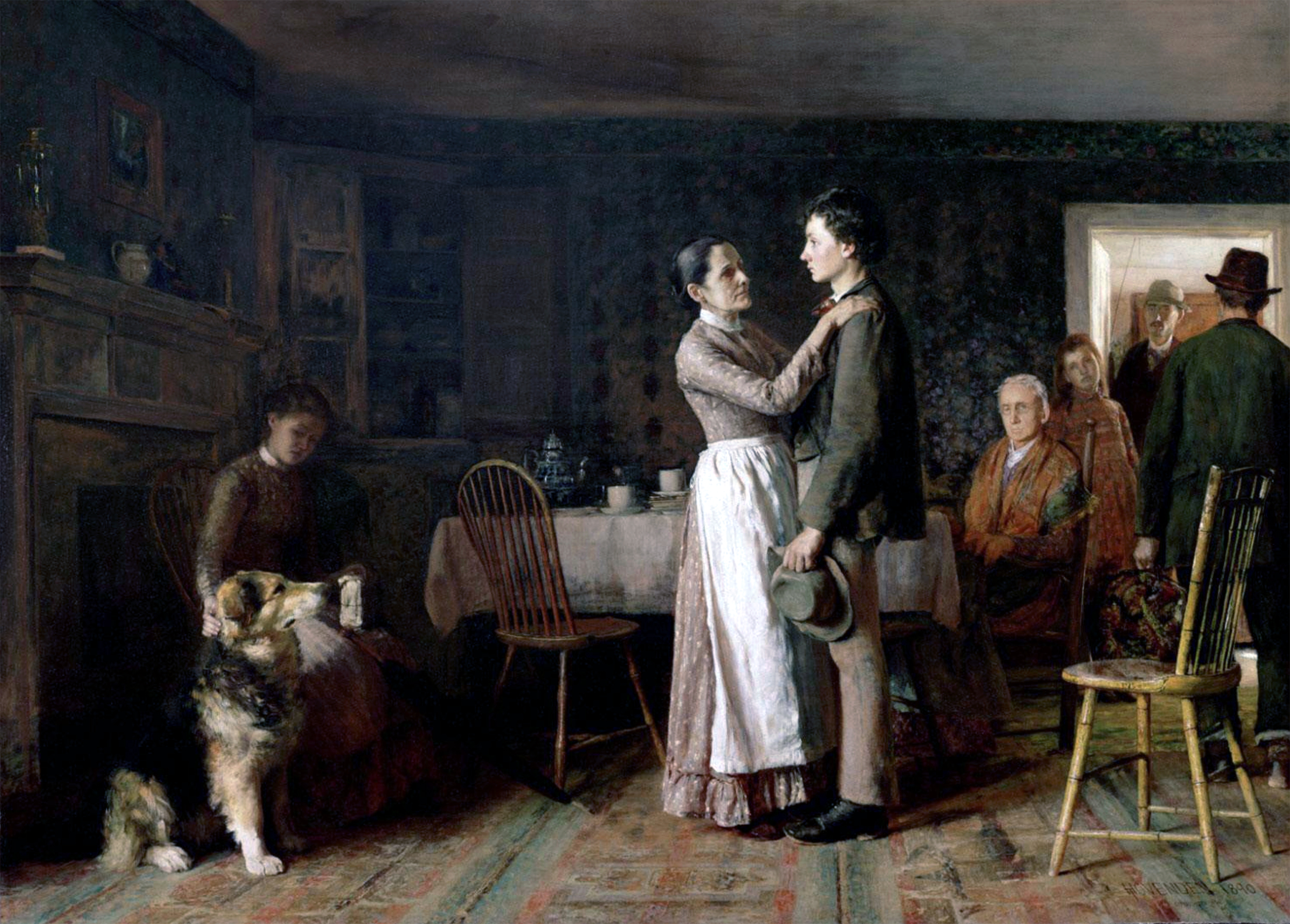
Critics gushed about the technical mastery of works like Sargent’s Portrait of Ellen Terry as Lady Macbeth and Whistler’s Lady with the Yellow Buskin, although many complained that American artists relied too heavily on European subjects, like Dutch tulip fields or the coast of Brittany. [8] Thomas Hovenden’s picture of a young man striking out on his own, Breaking Home Ties, was purported to be the most popular picture among visitors to the Fair, who appreciated its simple, “homely” sentiment. Philadelphians selected no fewer than 10 paintings by Thomas Eakins to exhibit at the Fair, among them The Gross Clinic (which had been painted for the 1876 Centennial Exhibition but rejected for its depiction of gore). [9]
The Women’s Building
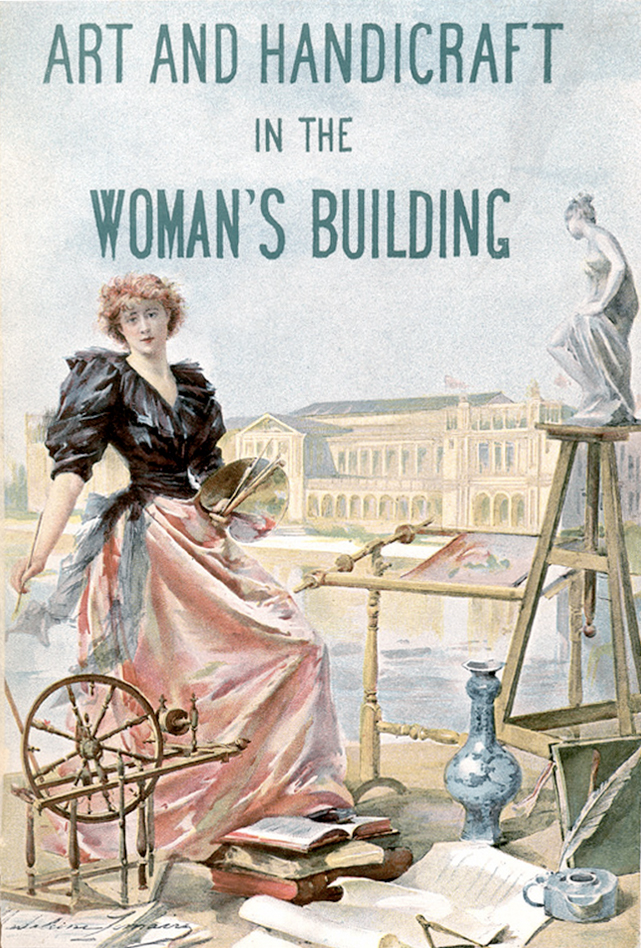
If our visitor had not yet collapsed from exhaustion, she may have turned toward the Women’s Building, the Fair’s second-smallest building, situated at the intersection between the White City and the Midway Plaisance. Despite a petition to name some women to the Fair’s governing body, Congress instead created a “Board of Lady Managers.” [10] They hoped to steer the Fair away from giving visitors the impression that the progress of civilization was entirely the work of men. Led by Bertha Palmer, a savvy businesswoman and wife of real estate magnate Potter Palmer, the Lady Managers attempted to secure exhibits from women in all of the Fair’s exhibition halls. Nearly all their applications for space, however, met with rejection. (Pressed to appoint women to judge submissions of fine art, the male directors deliberately appointed female artists who were either living abroad or lacking money to travel, thus preventing their participation.) [11] Eventually, the Lady Managers consigned themselves to exhibiting only in a dedicated Women’s Building.
The Women’s Building was the only one in the Fair whose design was open to competition, as professional women architects were just beginning to enter the field. The winning design, an Italian-Renaissance style palazzo, was the work of Chilean-American architect Sophia Hayden, the first female graduate of MIT’s four-year architecture program. Hayden’s design echoed those of the other exhibition halls in celebrating the styles of Italy as the highest form of architecture, but contemporaries, like the New York Times, remarked on the building’s “soft and soothing atmosphere of womanliness” and the evidence within that women’s achievements were the “more refined avenues of effort which culminate in the home, the hospital, the church, and in personal adornment.” [12] Within the structure, murals by women artists depicted the mythical progress of women over the centuries: the two largest, on either end of the building, were the murals by Mary Fairchild MacMonnies (painter and wife of Frederick), “Primitive Woman,” showing women carrying jugs of water on their heads and welcoming men back from the hunt, and Mary Cassatt, whose “Modern Woman” featured a triptych of young women pursuing fame, knowledge, and dance.
Despite their own frustrations with a Fair that sequestered women’s contributions, the Lady Managers nevertheless strongly supported its narrative of triumphant white civilization. They vociferously opposed appointing even a single Black woman to the Board, choosing instead to appoint a white woman to represent Black women’s interests. The only acknowledgement of the work of women of color in the Women’s Building was in a display of African, Asian, and Indigenous women’s crafts: baskets, netting, and blankets. Although they were made by contemporary artists, the exhibit suggested that they were the work of white women’s evolutionary ancestors: displays of what women’s arts had been like in the distant past, before modern white women had been able to devote themselves to the fine arts of painting and sculpture. [13]
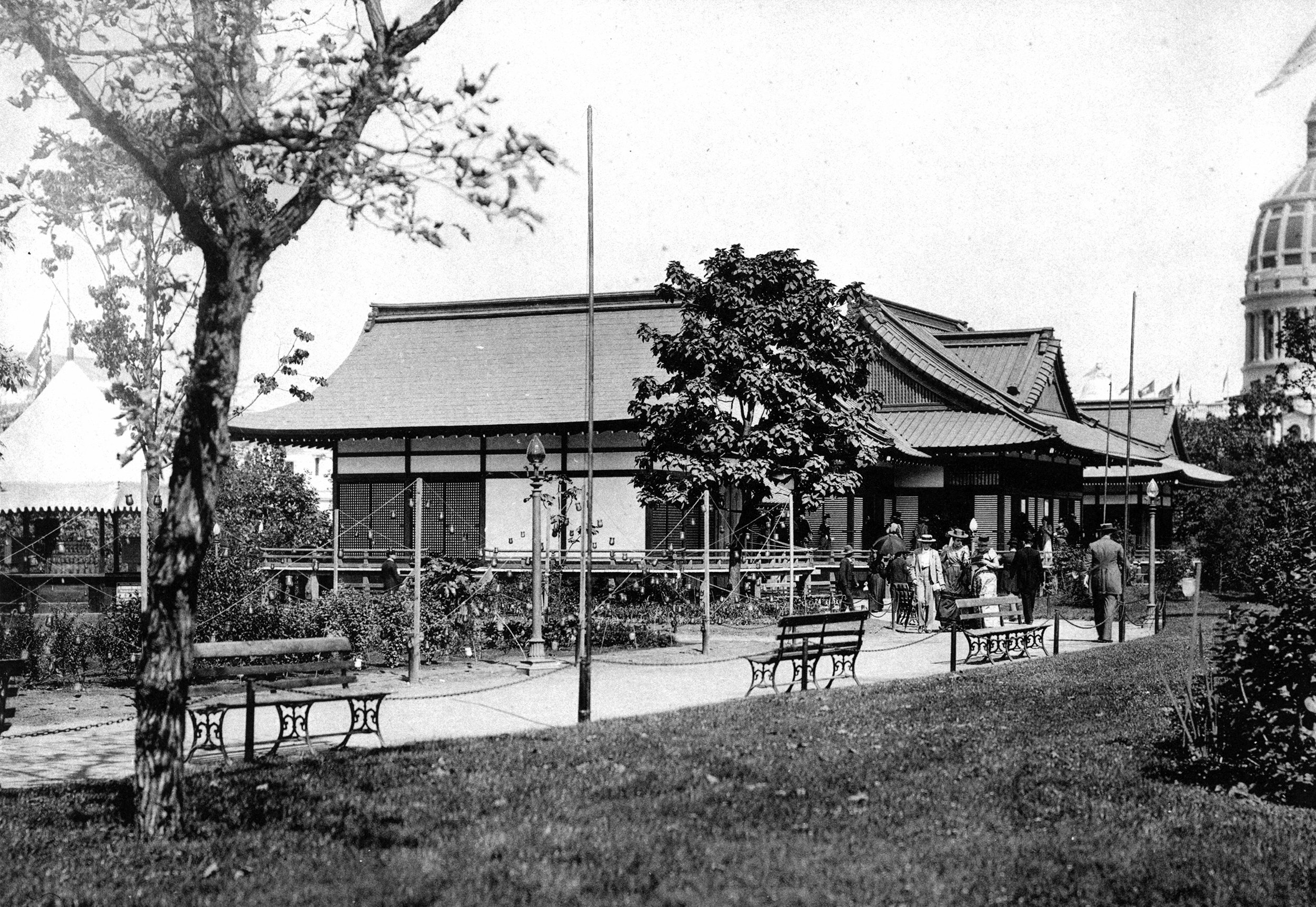
Naval power and new horizons
Having left the Women’s Building, our visitor may have chosen to browse some of the state and country pavilions at the north end of the fairgrounds, perhaps refreshing herself at the tea house at Ho-o-den, the beautiful Japanese pavilion situated on the Wooded Isle. Ho-o-den (the Phoenix Palace) was an authentic Japanese Pavilion designed by Masamichi Kuru, a Japanese architect who had studied western architecture. Situated within the main fairgrounds, but near the margin between the “civilized” and “uncivilized” worlds demarcated by the boundary leading to the Women’s Building and the Midway beyond, the position of the Japanese national pavilion symbolized its developing trade and cultural relationship with the United States. Or perhaps she would have stepped out to breathe some fresh air from Lake Michigan, seeing the display of emergent U.S. naval might in the concrete-and-wood replica of a U.S. battleship in the north harbor, a stark contrast to the replica of a diminutive Viking ship docked next to it. The Viking ship was built in Norway and sailed to the World’s Fair by way of the Atlantic, Hudson River, Erie Canal, and Great Lakes.
These were not the only ships at the Fair; if our visitor walked down the eastern border of the Fair past the Peristyle, she could marvel at exact reproductions of the three ships from Columbus’s voyage: the Niña, the Pinta, and the Santa Maria. Docked in the South Inlet, the Agricultural Building dwarfed the small caravels, which had been constructed in Spain and sailed to the Fair.
Indigenous Americans at the Fair
If our visitor continued into the southeastern corner of the Fair, she may have been greeted by a few unusual sights: a set of Penobscot bark tipis from the Northern Woodlands region of Maine and Quebec, a Kwakwaka’wakw village, a simulated mountain cliff dwelling of the southwest, plaster casts of Maya ruins, and a model boarding school for Indigenous children set up by the U.S. Office of Indian Affairs. Perhaps among this diverse and ersatz display of Indigenous cultures, she may even have seen Indigenous men in elaborate Plains war dress: members of Buffalo Bill’s Wild West show (set up just outside the Midway) touring the main fairgrounds in costume as “free advertising” for the spectacle. [14] What was she to make of these contrasts?
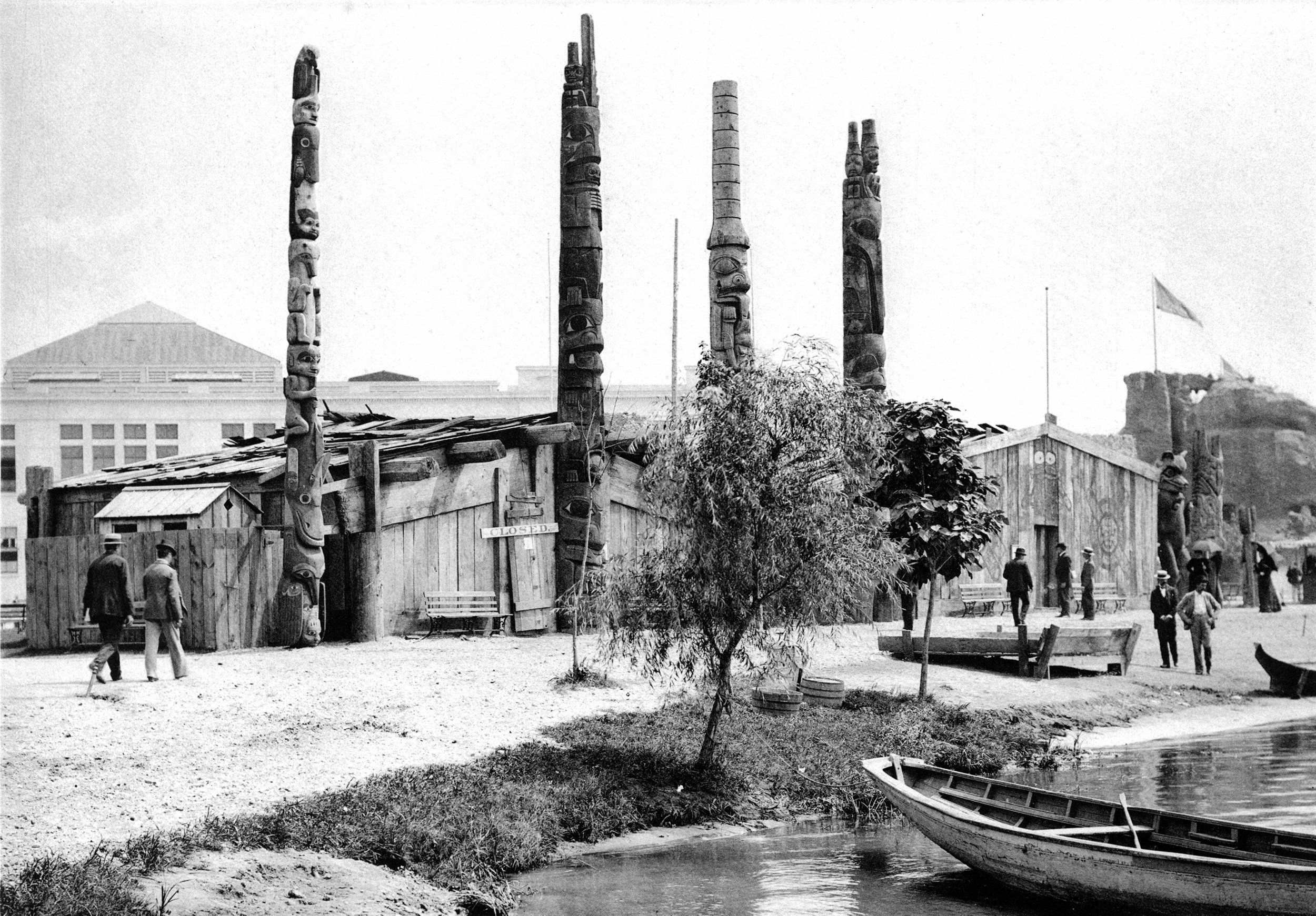
Just a few short years after the U.S. army massacre of Lakota Sioux men, women, and children at Wounded Knee, the Chicago World’s Fair was a site of contestation over the future of Indigenous people in the Americas. With the model boarding school—a working version of the schools that U.S. officials forced Indigenous children to attend in order to make them abandon Indigenous cultural practices and adopt white attitudes—the U.S. government made its commitment to exterminating Indigenous people and cultures clear. It was at the World’s Fair that many non-native peoples formed their impressions of Indigenous cultures, from the notion that they constituted a “vanishing race,” to the symbols of the feathered war-bonnet and the totem pole.
The Kwakwaka’wakw village was the work of the Department of Anthropology at the Fair. Directed by Frederic Putnam, with the help of his young assistant Franz Boas (who, as a professor at Columbia University, later became the “father of modern anthropology”), the Department of Anthropology enticed fourteen members of the Kwakwaka’wakw nation of British Columbia to live in a simulated village on the fairgrounds for the duration of the exposition and demonstrate their lifeways. Boas and other anthropologists also collected artifacts from Indigenous cultures across North America for display—the Smithsonian’s exhibit deployed these objects in museum dioramas featuring mannequins engaged in various handicrafts.
The anthropologists believed that Indigenous people were a dying race whose culture and objects must be preserved before they were either exterminated or made inauthentic by the influence of Euroamerican culture. The objects they collected for the Fair—along with the dioramas—would go on to form the basis of the collections at Chicago’s Field Museum. Indeed, anthropology as an academic discipline “came of age” at the Fair: the exhibits organized by the Smithsonian and the Peabody Museum introduced fairgoers to the nascent field, and museums across the country copied the geographically-arranged dioramas introduced there. [15]
But while the boarding school exhibit prescribed their extermination and the anthropological exhibits undertook to preserve objects that whites perceived as remnants that needed saving, Indigenous people themselves worked for their own benefit at the Fair, taking advantage of opportunities to earn money and resist repression. Kwakwaka’wakws performed ritual ceremonies, including the potlatch, which the Canadian government had outlawed. Even Buffalo Bill’s performers had found a way to earn a living through their traditional cultural practices. [16]
Left out of the Fair: Black Americans and protest
Within the main fairgrounds, our visitor would have had few if any opportunities to appreciate the contributions of Black Americans to the United States. Historians have characterized this era as the “nadir” of American race relations. Jim Crow laws received the stamp of constitutionality from the U.S. Supreme Court. The year 1893 had the greatest number of lynchings on record between 1882 and 1940. [17]
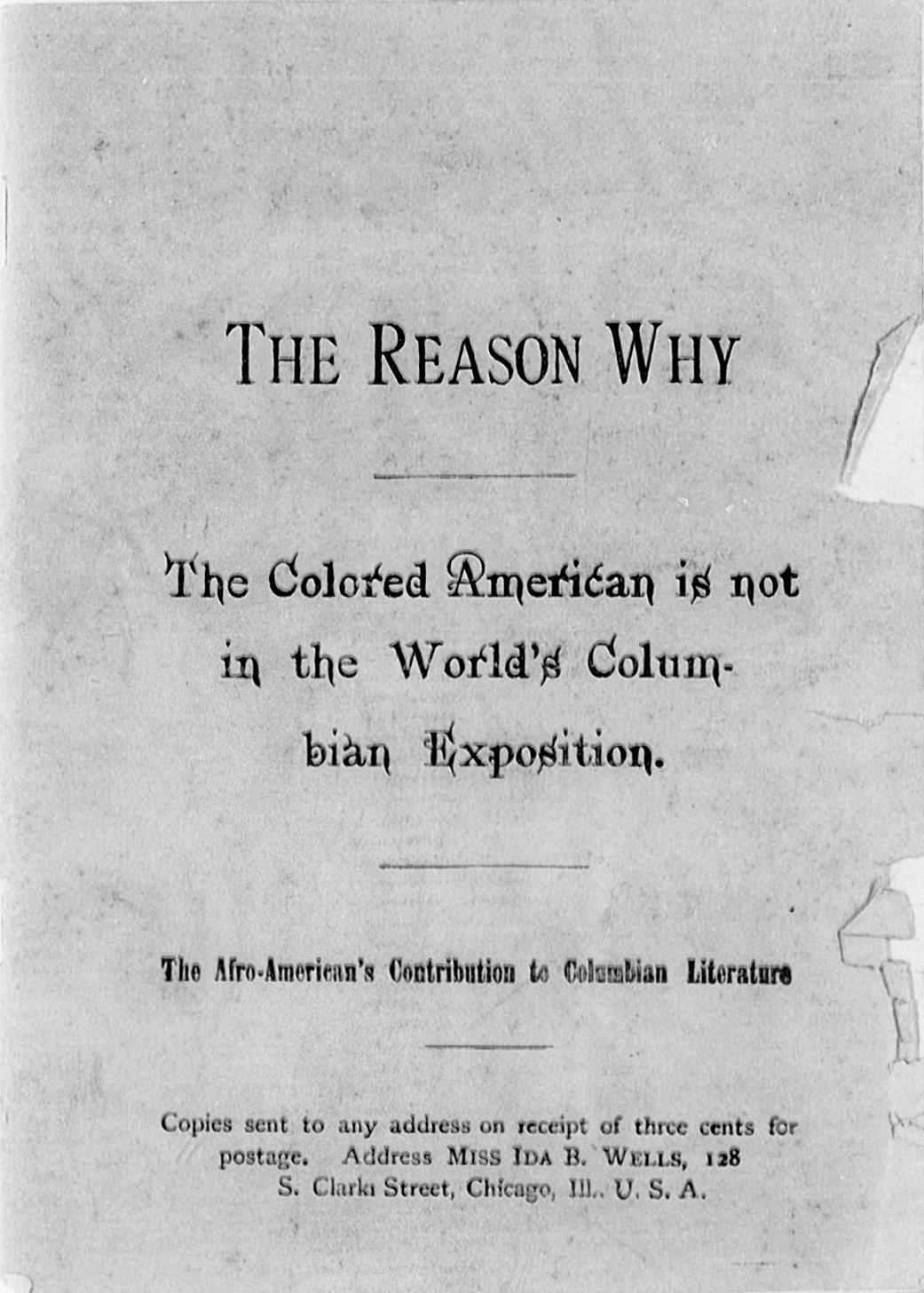
At first, the Black press promoted the World’s Fair as an opportunity to showcase the great accomplishments that Black Americans had made just one generation removed from slavery. But soon it became clear that Black citizens were faced with obstacles in every attempt they made to participate in the Fair. President Benjamin Harrison refused to appoint a Black representative to the organizing committee, and Black workers found there were only menial roles available to them in the construction and operation of the Fair. Decisions about the state pavilions were made by state legislatures and organizing commissions, which excluded Black participants and ignored Black contributions to society. Even a proposal for a segregated Colored Exhibit was denied. In short, the White City was a thoroughly and deliberately segregated space.
To protest the exclusion of Black Americans from the World’s Fair, anti-lynching activist Ida B. Wells and famous abolitionist Frederick Douglass (who had been appointed as a delegate for Haiti, not the United States) circulated 10,0000 copies of a pamphlet at the Fair entitled The Reason Why the Colored American Is Not in the World’s Columbian Exposition. With its introduction translated into French and German in order to reach a broad audience, the pamphlet explained the history of slavery, the ever-growing horrors of lynching, and contrasted those with the achievements Black citizens had made in business, education, science, and the arts. The pamphlet went on to expose how each effort made to participate in the Fair had been rebuffed, making plain the discrimination operating at every level.
Douglass wrote, furious, that the only real representation of Black people at the Fair were the Dahomeans, “here to exhibit the Negro as a repulsive savage.” [18] Although he employed the same rhetoric of savagery as white observers, he was right to identify the unique problems that the Fair’s racial narrative posed for Black Americans. “Perhaps one of the most striking lessons which the Columbian Exposition taught was that African slavery in America had not, after all, been an unmixed evil,” concluded one 1894 book dedicated to the Fair, “for of a truth, the advanced social conditions of American Africans over that of their barbarous countrymen is most encouraging and wonderful.” [19]
Conclusion
On July 5, 1894‚ more than eight months after the official close of the Fair, a massive fire destroyed all that remained of the White City. It was the fourth and largest fire that had taken place on the fairgrounds, and the only one set deliberately: strikers from the nearby factory town of Pullman set it ablaze. [20] Despite its triumphant narrative of cultural and scientific supremacy, the World’s Columbian Exposition arrived in the midst of a grim economy and an increasingly vocal working class. The Panic of 1893 led to the greatest economic depression the country had yet experienced, and the Great Strike of 1894 showed that beautiful architecture did not ensure a compliant labor force, not when their wages were slashed and rents increased.
But if the Fair’s ideas about art and capitalism failed to take hold, its messages about race and empire were widely embraced. In 1896, the Supreme Court permitted “separate but equal” public accommodations for white and Black citizens in its Plessy v. Ferguson decision, and in 1903 ruled that Congress did not have to honor treaties made with Indigenous nations. The numbers of Indigenous people living in the United States reached a “demographic nadir” of between 200,000 and 300,000 individuals around 1900, or less than 10% than had lived in North America before the arrival of Columbus. [21] And—although debates about the proper extent of U.S. imperialism abroad continued for several years—by the end of the century the U.S. government had taken possession of Hawai’i, Cuba, Puerto Rico, Guam, and the Philippines.
The World’s Columbian Exposition both reflected the dominant white theories of race and evolution of its day and reproduced them as spectacle, suggesting to its 27 million visitors that all the people of the world were on a continuum of civilization. But, to accomplish this, the White City had to exist in a constant state of comparison with the “uncivilized” portion of the Fair: the Midway.
Notes:
- Augustus Saint-Gaudens, quoted in Alan Trachtenberg, The Incorporation of America: Culture and Society in the Gilded Age (Hill and Wang, 1982), p. 217.
- Hamlin Garland in a letter to his parents, 1893. See A History of the Fair.
- See Robert W. Rydell, All the World’s a Fair: Visions of Empire at American International Expositions, 1876-1916 (University of Chicago Press, 1984), p. 46. This early version of the pledge was shorter: “I pledge allegiance to my Flag and the Republic for which it stands, one nation, indivisible, with liberty and justice for all.” The Catholic fraternal order, the Knights of Columbus, urged Congress to add “under God” to the pledge in the 1950s. On America the Beautiful, see Chaim M. Rosenberg, America at the Fair: Chicago’s 1893 World’s Columbian Exposition (Arcadia, 2008), p. 10.
- John J. Flinn, Official Guide to the World’s Columbian Exposition (The Columbian Guide Company, 1893), p. 39.
- Flinn, p. 40.
- Quoted in Trachtenberg, p. 213.
- Carolyn Kinder Carr, Revisiting the White City: American Art at the 2893 World’s Fair (National Museum of American Art and National Portrait Gallery, 1993), p. 178.
- Carr, p. 178.
- Carr, p. 100-102.
- Gail Bederman, Manliness & Civilization: A Cultural History of Gender and Race in the United States, 1880-1917 (University of Chicago Press, 1995), p. 33.
- Carr, pp. 81-82.
- Quoted in Bederman, p. 34.
- Bederman, p. 38.
- David R. M. Beck, Unfair Labor? American Indians and the 1893 World’s Columbian Exposition in Chicago (University of Nebraska Press, 2019), p. 39.
- See Curtis M. Hinsley and David R. Wilcox, eds., Coming of Age in Chicago : The 1893 World’s Fair and the Coalescence of American Anthropology (University of Nebraska Press, 2016).
- Beck, p. xvii.
- See Charles Seguin and David Rigby, “National Crimes: A New National Data Set of Lynchings in the United States, 1883 to 1941,” Socius: Sociological Research for a Dynamic World, May 6, 2019.
- Ida B. Wells and Frederick Douglass, The Reason Why The Colored American is Not in the World’s Columbian Exposition, 1893.
- Quoted in Rydell, p. 53.
- Trachtenberg, p. 209.
- Douglas H. Ubelaker, “North American Indian population size, A.D. 1500 to 1985,” American Journal of Physical Anthropology, vol. 77, no. 3 (Nov. 1988), pp. 389-294.
Additional resources
Learn more about the architecture of the Court of Honor
Watch a lecture on the anthropology exhibits at the White City
See an interactive map of the Fair from the Harvard Worldmap Platform
Alan Trachtenberg, The Incorporation of America: Culture and Society in the Gilded Age (Hill and Wang, 1982).
Carolyn Kinder Carr, Revisiting the White City: American Art at the 2893 World’s Fair (National Museum of American Art and National Portrait Gallery, 1993).

